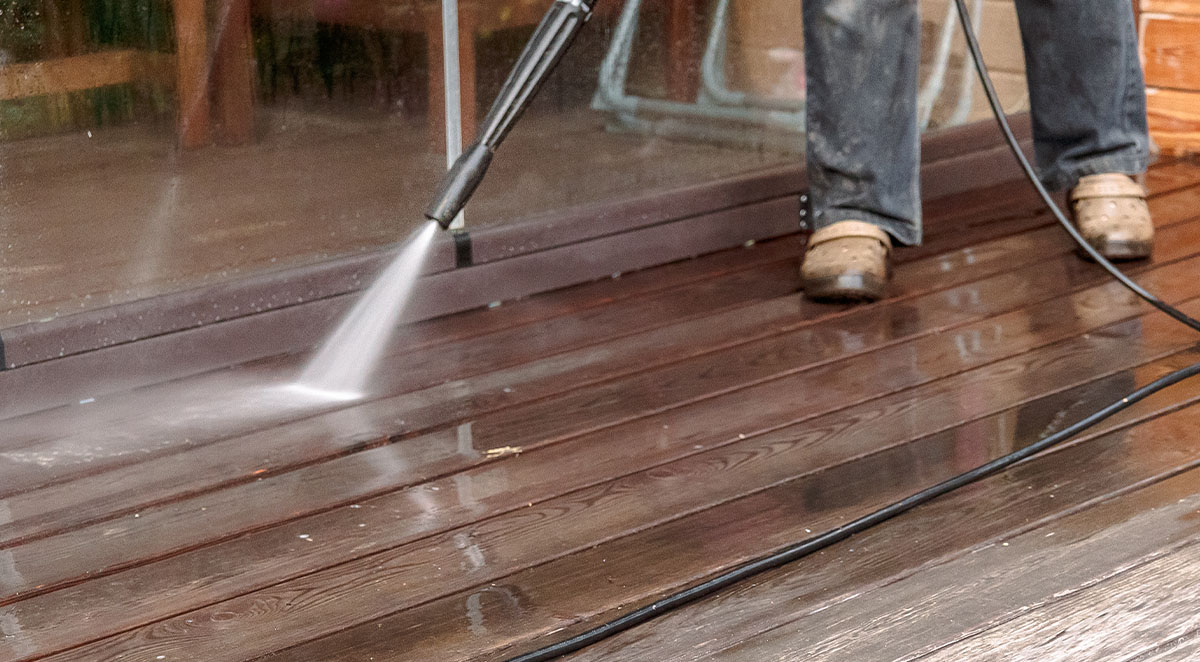With summer in full swing, there is no better time to work on outdoor home improvements than now. After a tough winter and a pollen-filled spring, the surfaces in and around your home are ready for a thorough cleaning. It's time to start preparing for the rest of the summer by learning how to clean the exterior of your home.
In Summer Washing Essentials, Part 1, we covered the benefits of professional pressure washing during the summer month. In this blog, we will continue to discuss the safety precautions you should follow and how to properly use a pressure washer this summer.
Six Safety Precautions You Should Follow
1. Stand on a Stable Surface
Before you begin, place your feet on a stable, flat surface. Pressure washers can have some kickback, so be sure you’re on a surface that won’t cause you to lose your balance if it gets wet.
2. Protect Your Eyes and Ears
Pressure washing is the process of spraying pressurized water at a surface to clean dirt and debris. When sprayed, the dirt and debris can break into little pieces and fly several feet away and pose a risk to your eyes and ears. Not to mention, the pressure of the water can cause serious damage to your eyes.
Invest in a good pair of safety eyewear and ear protection. If you have small children or pets, bring them inside before you begin pressure washing.
3. Protect Yourself and Cover Your Skin
When pressure washing, it is important to protect your skin. To protect your skin from excessive amounts of water and cleaning solvents, wear thick gloves and a water-resistant jacket. If you're going to be outside for a long period of time, wear water-resistant sunscreen.
4. Choose the Right Cleaner
One thing to remember is that soap and detergent are not the same things. Pressure washer soaps contain more natural components, such as fats or oils, to break down dirt and grime.
Detergents, on the other hand, are chemically based and entirely synthetic. Going more natural may be preferred in this case, especially if children, animals, or pets are involved.
If not properly rinsed, certain soaps leave calcium deposits and hard water stains, whereas detergents are designed to avoid this. Nonetheless, some homeowners prefer natural solutions like vinegar and ammonia to avoid harsh chemicals altogether.
5. Avoid Windows and Vents
Maintain a safe distance between high-pressure spray and windows and outside vents. If sprayed directly, the power of the pressurized water has the potential to shatter windows.
In terms of pressure, it is also important to determine which nozzle will provide the appropriate pressure for the surface you are cleaning.
Similarly, exterior vents designed to vent air downward may cause an upward spray of water to damage your home's HVAC or venting systems. Flooding vents may result in mold, mildew, or premature decaying of wood in your home.
6. Cover Up Power Sources
Cover any exposed electrical outlets or fixtures in the pressure-cleaning area with plastic. This ensures your safety while also avoiding the need to replace any outlets that would short circuit as a result of water exposure.
How to Use a Pressure Washer
Prep the Area:
Start by prepping the area you plan to pressure wash including removing potted plants and patio furniture. Lay down a tarp over plants and landscaping to protect them from the solution. Sweep away any dirt, debris, or rocks that could become projectiles.
Choose Pressure Washer:
Before you start, you must decide whether you will buy or rent a pressure washer, as well as the type of pressure washer that is best for you. A gas-powered pressure washer is recommended for heavy-duty jobs like cleaning siding or removing oil stains from driveways. An electric pressure washer is great for small jobs like washing your car or grill.
Attach the Garden Hose:
Using a garden hose, connect the pressure washer to the water supply line. Before turning on the pressure washer, double-check that all connections are tight. Next, turn on the water supply and test out the nozzle by squeezing the trigger on the pressure washer head.
Start Your Project:
Once you have everything set up and you’ve read the pressure washer's manual, it’s time to begin your project. To ensure an even cleaning, begin at the top of the project and work your way down.
HydroClean Summer Pressure Washing
While some home improvement projects can easily be tackled by DIYers, other higher-skilled projects should be left to professionals. Hiring a professional to pressure wash the outside of your property can leave a lasting impression and give you more time to enjoy the summer!
HydroClean offers professional household pressure cleaning services in Asheville, North Carolina. To learn more about our residential pressure cleaning services, contact us.

